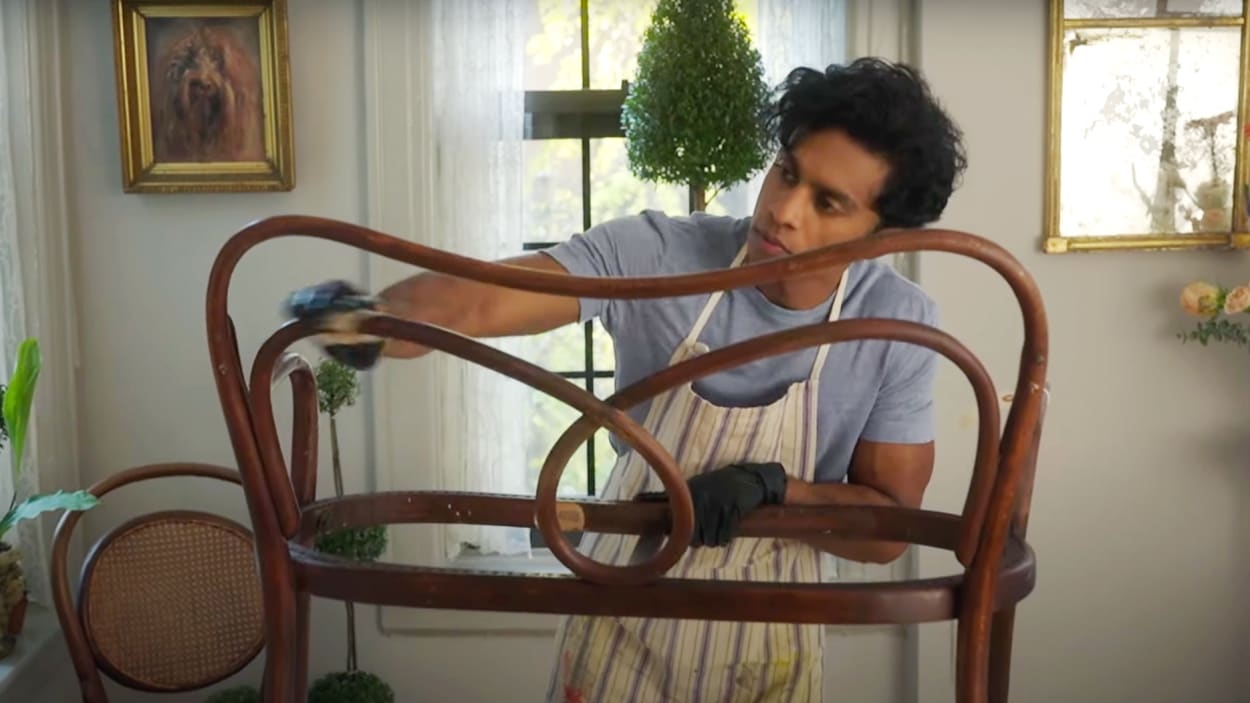If a person is what they do, it’s hard to describe Rajiv Surendra in a pithy sentence—or even a paragraph. He’s a professional calligraphist and chalk artist. He makes and sells soap, candles, and flowerpots. He had a memorable supporting role in Mean Girls, which people still stop him on the street to ask about, and he wrote a well-reviewed memoir called Elephants in My Backyard. He also canes chairs, plays the harp, and has a background in beekeeping.
These days, however, what Surendra is increasingly known for is channeling his myriad skills and boundless enthusiasm into videos celebrating creativity as a way of life.
“Rajiv has a natural curiosity about the world, an eye for beauty, and his sense of wonder is contagious,” says Stephanie L. Herdrich, a curator at The Met, whose social media team recently partnered with Surendra on a video series.
Although he may appear to be a walking collection of successful New Year’s resolutions, Surendra has never made one of those before and did not start this year. Instead, the HGTV star kicked off 2023 by launching a new YouTube channel: a hub for sharing his passions, whether they be upholstering furniture, cooking Tamil cuisine, or ironing a shirt to completion. It’s not just that he can do seemingly anything—or that it’s entertaining to watch him do it—that makes Surendra an ideal guide for anyone chasing their curiosity down the rabbit hole. What makes him so well-suited for this role is the philosophy underlying all his creative pursuits, one that emerged out of finding something he couldn’t do.
Feeding the tiger
One of Surendra’s earliest memories involves making something. As a toddler, he once helped his mother create bathtub-gin Play-Doh out of flour and food coloring. The ecstatic happiness he found in the process itself, and the malleable mush it produced, is forever seared into his brain. It was a baptism of sorts for a childhood flush with hobbies and start-from-scratch ingenuity.
“I liken it to a hunger,” he says over Zoom recently. “It felt like this hunger that really needed to be fed. I was always searching for an outlet.”
Some of the places he searched include ornamental pen design, gilding picture frames, setting up and tending to chicken coops, drawing henna tattoos, hand-pollinating blossoms, and growing all kinds of weird plants in old fishing tanks. His obsession with making things meshed with a love of make-believe, too. He longed to inhabit imaginary or long-ago worlds—drawing hieroglyphics on his basement walls, for instance—which put him on a path toward an acting career.
It was on the set of Mean Girls in 2003 that a teenage Surendra discovered the book that would change his life: Yann Martel’s mega-bestseller Life of Pi. He felt an instant connection with its narrator, a fellow Tamil boy who had also grown up learning French and living near a zoo. (The Toronto Zoo for Surendra; the Pondicherry Zoo for Pi Patel.) When he found out a film version of Life of Pi was in the works, Surendra embarked upon what turned out to be a seven-year odyssey to land the lead role. He befriended the book’s author, came face-to-face with a tiger, learned to swim, and even spent several months living in Pondicherry, India, to see the world through Pi Patel’s eyes—all of which he chronicled in his book, Elephants in My Backyard. Ultimately, however, actor Suraj Sharma got the part. Surendra was devastated.
“I felt kind of dead inside,” he says, “because I had created a real person inside of me who was this character, and then in one instant it was as if that person died.”
By losing the acting role he’d built up as the key to his future, though, he gained something far more valuable.
He realized he was still happy with the self-knowledge and experience that unfolded during his journey, and that he’d do it all over again even if it ended the same way. Out of his disappointment rose a new outlook that has since resonated in every aspect of his life, his hobbies, and his career.

“The experience with Life of Pi taught me two things: to live in the present and to really go for things,” he says. “Even if something you want seems really outlandish, if you don’t achieve it, you will still learn something about yourself in the process. Most people weigh their options based on the chances of success, and I feel like there’s no magic in that.”
Just jump in
It’s only natural for dreams to evolve and change as we come to understand more of what we want, rather than what we’re supposed to want—or what we’ve convinced ourselves to want. When Surendra started asking himself what he truly wanted out of life, many answers came to mind, most prominently: to wake up every morning feeling content.
It’s a tall order, but maybe not as much as it seems.
“If you can find contentment in a single moment,” he says, “you understand what it takes to find contentment, and you can have it every day.”
After the dust settled from his Life of Pi adventure, Surendra found a way to turn a source of contentment into a means for supporting himself. He started a calligraphy business, Letters in Ink, and went on to do signage design and chalk art for clients as varied as the Newark Airport and the Kips Bay Decorator Showhouse, along with a plethora of restaurants in Toronto and Manhattan.
Calligraphy is a skill he’s been cultivating since age 12, when he first spied some handwritten letters from the 1870s and admired their beauty. He had no long-term goals for the hobby, no adolescent dream of one day turning elegant handwriting into an actor’s side hustle. Perhaps it was this very absence of pressure to achieve anything with his art that allowed him to casually develop it for nearly a decade before turning it into a business.
Surendra has taken pains to ensure his calligraphy and chalk art retain the purity of what drew him in initially and sustained him over the years it took to hone his talent. When he started the business, he worried that being paid to do calligraphy would ruin it for him, so he added a failsafe. He vowed not take on any client who asked him to do work he found ugly or just plain awful. It cost him a big job early on, when he objected to an unnamed major coffee company’s mandate, but it’s helped him to remain content with his work ever since.
“If the monetizing is going to affect the practice, it’s not worth it to me,” Surendra says. “The main incentive for monetizing the practice is to fuel the practice.”
The painful process of making really bad pottery for a long time
Like almost everyone on the planet, Rajiv Surendra was horrified by the onset of the pandemic. At the same time, he was also quietly grateful for the opportunity it provided.
“Nobody knew how long it would last,” he says, “and I just thought, when it’s over, it would be nice to know I’d used that time really well.”
In the year between lockdown and vaccine rollout, Surendra had a creative renaissance. The first thing he did was learn how to re-cane the worn-out wicker seat of a beloved chair in his home. He had long ago purchased supplies for the job, but never set aside time to see it through. Now there were no excuses.
It took an entire week, but he fixed the chair seat. That project then became a springboard into the ocean of homebound creativity that followed.
Surendra slowly accumulated a schedule of activities, essentially enrolling himself in Adult Summer Camp. He started his days at 4 a.m., with an hour of yoga and an hour of meditation, then dedicated an hour each to learning how to play the piano, harp, and guitar, along with a rotating hour of either watercolor, oil painting, or sketching. He would make long, leisurely meals at night, before hitting the sack at a child’s bedtime of 8 p.m. The only way he was capable of sustaining such an intense regimen, though, was by spending Sundays doing nothing at all.
Along with Surendra’s whirlwind of pandemic activity came a new habit of documenting it all on social media.
In the leadup to the 2016 release of Elephants in My Backyard, Surendra’s literary agent sternly nudged him to start using Instagram for self-promotion. He was hesitant—it wasn’t by accident that he did not yet have Instagram—but took to it quickly. In the ensuing years, he built a modest following on the app with videos about calligraphy and his other pursuits. In the pandemic, though, that audience ballooned toward his current 109,000 Insta followers. Greeting viewers with a wry, “Hi boys and girls,” Surendra would show off his latest latte art, or play from the Chopin nocturne he was learning on piano. Whether it was because everyone else was stuck at home too, or because his creative renaissance was simply fascinating to witness, people showed up in droves.
Watching his audience grow only fed his fire to keep going further.
“I felt like seeing what I was doing could help people discover that aspect in themselves that would make them slow down, focus, and take the time to really learn something new,” he says.
Surendra’s experience with Life of Pi had taught him the inherent value of going after things. Somewhere along the way, though, he also developed a respect for discipline: the difference between merely getting to the end of something and doing it properly. Learning anything truly well requires vast reserves of discipline—and not everything one might want to learn in life will be worth all that effort.
While Surendra’s fans have a front row seat to all the projects he’s started and stuck with, very few people are aware of how many he’s started and abandoned. He tried learning to play banjo, for instance, but it didn’t take. He has given up at least three separate efforts of learning how to make a 16th century man’s doublet and hose. Rather than failures, however, he looks at these misfires as a way of Kondo-ing his creative life: removing things that don’t spark joy.
But it’s important to know the difference between something that doesn’t spark joy and something that’s just a pain in the ass at first.
“There’s always a moment in learning anything that’s a real struggle,” he says. “It’s a very blurry place where people are intrigued by something and then they mistake ‘This is really hard’ for ‘Eh, this isn’t for me.’ If it’s just that it’s hard, you should stick with it and go through the painful process of making really shitty pottery for a long time before it starts being good.”
Wow, at least you did that
Surendra’s onscreen persona is that of a serenely patient hobby-concierge, making the impossible feel within reach and the impractical look kind of fun. (Bookbinding, anyone?)
No wonder HGTV eventually came calling.
“I knew of Rajiv as an actor, but read an article about his chalk art career and had to know more,” says HGTV Handmade producer Liz Gray. “From there, our team realized he’d renovated his apartment during the pandemic with an eye for artful, handmade details—the perfect fit for Handmade’s Home Tour series.”
The resulting video ended up going viral at a level the channel had not previously seen.
“It was clear that Rajiv’s passion for Old World artistic pursuits really struck a chord with our audience,” Gray adds.
When the video hit a million views, on the path to an eventual 3.4 million, Rajiv proposed teaming up further. The network was open to it. Over the next year, they released more than 20 videos together, following Surendra around as he went thrifting or carved wooden cutting boards.
The videos were such a hit that HGTV tapped him to film a pilot for a TV show called Homeboy. In it, he can be seen riding around New York on a vintage bicycle, wearing impeccably dandified drip, going about all his various hobbies. Amid the impending merger between Warner Bros. and Discovery, though, the show was unceremoniously dumped on the nascent Discovery+ streaming service, with practically zero promotion. It did not receive a full series order.
Surendra was disappointed by this outcome, but he found it relatively easy to shrug off.
“If this would have happened before Life of Pi, it would have been devastating, but I no longer have this yearning for ‘If this thing happens, I will feel fulfilled,’” he says. “I feel like all of these successes are just bonuses, like the little one-ups in Super Mario Bros. My true success is knowing I have the freedom to juggle my work with biking to Brooklyn or sitting at my harp or painting with my watercolors every day if I want.”
While too few people watched Homeboy to make it a hit, at least one VIP did see it: Surendra’s Mean Girls costar and writer, Tina Fey. After hearing about the fate of his show, she told Surendra she loved what she’d seen of it, and suggested they cook up a similar project together. It’s a thrilling prospect for the future, which he dares not jinx by saying too much about. Until that potential collaboration comes to fruition, though, he is throwing himself entirely into his just-launched YouTube channel.
Close friends and fellow influencers had been urging Surendra to take this step for a long time, but he could not see himself filming and editing his own videos at a professional level. (As open to learning new things as he is, Surendra remains a fairly committed Luddite.) Working with HGTV, however, gave him a taste of would it would be like to do his thing on camera while other people fussed over the detested tech elements. Last fall, he started a Gofundme to underwrite the production expenses for a proper YouTube channel, and sure enough, money quickly followed.
In the three weeks since he dropped his first video, an ode to washing whites exceptionally well, Surendra’s channel already has 45,000 subscribers. Even if his channel rockets to the top of YouTube’s recommendation algorithm, though, and ad revenues rain down from above, he will always be prouder of the skills on display within the videos than any material success they generate.
“When I ask myself what I want to achieve out of this life, I ultimately want to know that I saw something that inspired me and I worked very hard to learn how to do it at a high level,” he says. “Whenever my last day is on this earth, if I have a moment to reflect back on my life and think about how I spent my time here, I want to look back at those skills that took me hard work to achieve and think, ‘Wow, at least you did that. That was worthy of your time.’”
(8)





